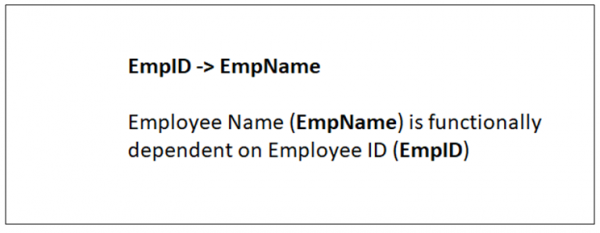
 Data Structure
Data Structure Networking
Networking RDBMS
RDBMS Operating System
Operating System Java
Java MS Excel
MS Excel iOS
iOS HTML
HTML CSS
CSS Android
Android Python
Python C Programming
C Programming C++
C++ C#
C# MongoDB
MongoDB MySQL
MySQL Javascript
Javascript PHP
PHP
- Selected Reading
- UPSC IAS Exams Notes
- Developer's Best Practices
- Questions and Answers
- Effective Resume Writing
- HR Interview Questions
- Computer Glossary
- Who is Who
Types of dependencies in DBMS
Dependencies in DBMS is a relation between two or more attributes. It has the following types in DBMS ?
- Functional Dependency
- Fully-Functional Dependency
- Transitive Dependency
- Multivalued Dependency
- Partial Dependency
Let us start with Functional Dependency ?
Functional Dependency
If the information stored in a table can uniquely determine another information in the same table, then it is called Functional Dependency. Consider it as an association between two attributes of the same relation.
If P functionally determines Q, then
| P -> Q |
Let us see an example ?
<Employee>
| EmpID | EmpName | EmpAge |
| E01 | Amit | 28 |
| E02 | Rohit | 31 |
In the above table, EmpName is functionally dependent on EmpID because EmpName can take only one value for the given value of EmpID:
| EmpID -> EmpName |
The same is displayed below ?

Fully-functionally Dependency
An attribute is fully functional dependent on another attribute, if it is Functionally Dependent on that attribute and not on any of its proper subset.
For example, an attribute Q is fully functional dependent on another attribute P, if it is Functionally Dependent on P and not on any of the proper subset of P.
Let us see an example ?
<ProjectCost>
| ProjectID | ProjectCost |
| 001 | 1000 |
| 002 | 5000 |
<EmployeeProject>
| EmpID | ProjectID | Days (spent on the project) |
| E099 | 001 | 320 |
| E056 | 002 | 190 |
The above relations states:
| EmpID, ProjectID, ProjectCost -> Days |
However, it is not fully functional dependent.
Whereas the subset {EmpID, ProjectID} can easily determine the {Days} spent on the project by the employee.
This summarizes and gives our fully functional dependency ?
| {EmpID, ProjectID} -> (Days) |
Transitive Dependency
When an indirect relationship causes functional dependency it is called Transitive Dependency.
If P -> Q and Q -> R is true, then P-> R is a transitive dependency.
Multivalued Dependency
When existence of one or more rows in a table implies one or more other rows in the same table, then the Multi-valued dependencies occur.
If a table has attributes P, Q and R, then Q and R are multi-valued facts of P.
It is represented by double arrow ?
| ->-> |
For our example:
| P->->QQ->->R |
In the above case, Multivalued Dependency exists only if Q and R are independent attributes.
Partial Dependency
Partial Dependency occurs when a nonprime attribute is functionally dependent on part of a candidate key.
The 2nd Normal Form (2NF) eliminates the Partial Dependency. Let us see an example ?
<StudentProject>
| StudentID | ProjectNo | StudentName | ProjectName |
| S01 | 199 | Katie | Geo Location |
| S02 | 120 | Ollie | Cluster Exploration |
In the above table, we have partial dependency; let us see how ?
The prime key attributes are StudentID and ProjectNo.
As stated, the non-prime attributes i.e. StudentName and ProjectName should be functionally dependent on part of a candidate key, to be Partial Dependent.
The StudentName can be determined by StudentID that makes the relation Partial Dependent.
The ProjectName can be determined by ProjectID, which that the relation Partial Dependent.

